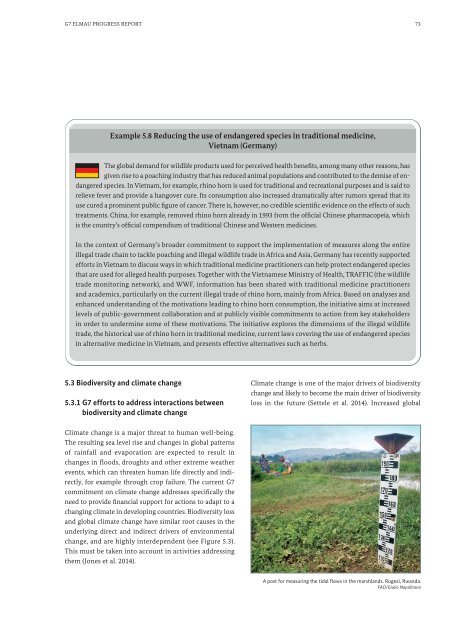G7-Elmau-Progress-Report-2015-Biodiversity-A-vital-foundation-for-sustainable-development
G7-Elmau-Progress-Report-2015-Biodiversity-A-vital-foundation-for-sustainable-development
G7-Elmau-Progress-Report-2015-Biodiversity-A-vital-foundation-for-sustainable-development
You also want an ePaper? Increase the reach of your titles
YUMPU automatically turns print PDFs into web optimized ePapers that Google loves.
<strong>G7</strong> ELMAU PROGRESS REPORT 73Example 5.8 Reducing the use of endangered species in traditional medicine,Vietnam (Germany)The global demand <strong>for</strong> wildlife products used <strong>for</strong> perceived health benefits, among many other reasons, hasgiven rise to a poaching industry that has reduced animal populations and contributed to the demise of endangeredspecies. In Vietnam, <strong>for</strong> example, rhino horn is used <strong>for</strong> traditional and recreational purposes and is said torelieve fever and provide a hangover cure. Its consumption also increased dramatically after rumors spread that itsuse cured a prominent public figure of cancer. There is, however, no credible scientific evidence on the effects of suchtreatments. China, <strong>for</strong> example, removed rhino horn already in 1993 from the official Chinese pharmacopeia, whichis the country’s official compendium of traditional Chinese and Western medicines.In the context of Germany’s broader commitment to support the implementation of measures along the entireillegal trade chain to tackle poaching and illegal wildlife trade in Africa and Asia, Germany has recently supportedef<strong>for</strong>ts in Vietnam to discuss ways in which traditional medicine practitioners can help protect endangered speciesthat are used <strong>for</strong> alleged health purposes. Together with the Vietnamese Ministry of Health, TRAFFIC (the wildlifetrade monitoring network), and WWF, in<strong>for</strong>mation has been shared with traditional medicine practitionersand academics, particularly on the current illegal trade of rhino horn, mainly from Africa. Based on analyses andenhanced understanding of the motivations leading to rhino horn consumption, the initiative aims at increasedlevels of public-government collaboration and at publicly visible commitments to action from key stakeholdersin order to undermine some of these motivations. The initiative explores the dimensions of the illegal wildlifetrade, the historical use of rhino horn in traditional medicine, current laws covering the use of endangered speciesin alternative medicine in Vietnam, and presents effective alternatives such as herbs.5.3 <strong>Biodiversity</strong> and climate change5.3.1 <strong>G7</strong> ef<strong>for</strong>ts to address interactions betweenbiodiversity and climate changeClimate change is one of the major drivers of biodiversitychange and likely to become the main driver of biodiversityloss in the future (Settele et al. 2014). Increased globalClimate change is a major threat to human well-being.The resulting sea level rise and changes in global patternsof rainfall and evaporation are expected to result inchanges in floods, droughts and other extreme weatherevents, which can threaten human life directly and indirectly,<strong>for</strong> example through crop failure. The current <strong>G7</strong>commitment on climate change addresses specifically theneed to provide financial support <strong>for</strong> actions to adapt to achanging climate in developing countries. <strong>Biodiversity</strong> lossand global climate change have similar root causes in theunderlying direct and indirect drivers of environmentalchange, and are highly interdependent (see Figure 5.3).This must be taken into account in activities addressingthem (Jones et al. 2014).A post <strong>for</strong> measuring the tidal flows in the marshlands. Rugezi, Rwanda.FAO/Giulio Napolitano


